Return Of The Video Jedi
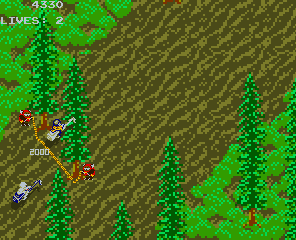 Atari releases the arcade game Return Of The Jedi in the United States, completing its own coin-op Star Wars trilogy and allowing players to participate in the thrill of helping Ewoks snag Imperial speeder bikes out of mid-air.
Atari releases the arcade game Return Of The Jedi in the United States, completing its own coin-op Star Wars trilogy and allowing players to participate in the thrill of helping Ewoks snag Imperial speeder bikes out of mid-air.
Buggy Challenge
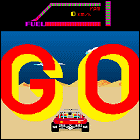 The American wing of Japanese arcade game manufacturer Taito introduces the coin-op racing game Buggy Challenge on the American arcade market.
The American wing of Japanese arcade game manufacturer Taito introduces the coin-op racing game Buggy Challenge on the American arcade market.
Time Pilot ’84
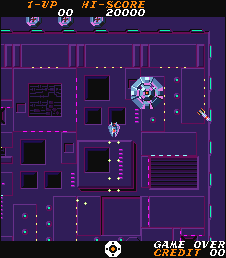 Konami introduces the arcade game Time Pilot ’84 in the United States, dragging the popular Time Pilot style of game play two years into the future. (In many respects, it’s the same game with a new graphics set.)
Konami introduces the arcade game Time Pilot ’84 in the United States, dragging the popular Time Pilot style of game play two years into the future. (In many respects, it’s the same game with a new graphics set.)
Tube Panic
 Mixing video highway hypnosis and a strangely hummable theme song, Japanese video game Tube Panic, from the makers of Crazy Climber and Moon Cresta, first appears in American arcades. Players have to fight motion sickness to keep blasting away at bad guys. The game achieves minor cult status but fails to become a smash hit at a time when arcade manufacturers desperately need one.
Mixing video highway hypnosis and a strangely hummable theme song, Japanese video game Tube Panic, from the makers of Crazy Climber and Moon Cresta, first appears in American arcades. Players have to fight motion sickness to keep blasting away at bad guys. The game achieves minor cult status but fails to become a smash hit at a time when arcade manufacturers desperately need one.
Odyssey2 production ends
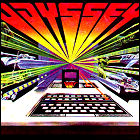 Like many other companies tied into the video game business – whose profits seem to be in an endless downward spiral – North American Phillips (formerly Magnavox) closes down production of Odyssey2 hardware and software, and reassigns staff programmers to other products, including Phillips’ stand-alone word processor, VideoWriter, though few of the company’s former game designers remain with that project for long.
Like many other companies tied into the video game business – whose profits seem to be in an endless downward spiral – North American Phillips (formerly Magnavox) closes down production of Odyssey2 hardware and software, and reassigns staff programmers to other products, including Phillips’ stand-alone word processor, VideoWriter, though few of the company’s former game designers remain with that project for long.
Circus Charlie
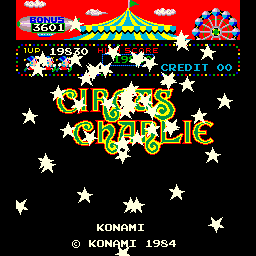 Konami introduces the arcade game Circus Charlie in the United States. Patterned after the Olympic-themed Track & Field, Circus Charlie is a “multi-event” game based on circus tricks.
Konami introduces the arcade game Circus Charlie in the United States. Patterned after the Olympic-themed Track & Field, Circus Charlie is a “multi-event” game based on circus tricks.
Pitfall II: Lost Caverns
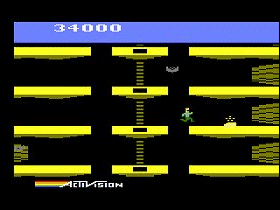 Activision releases the Pitfall II: Lost Caverns cartridge for the Atari 2600 home video game system, adding new adventures to Pitfall Harry’s resume and wowing players with sophisticated polyphonic music from a console infamous for its buzzes, bleeps and bloops. (The secret: the cartridge contains its own special audio chip.)
Activision releases the Pitfall II: Lost Caverns cartridge for the Atari 2600 home video game system, adding new adventures to Pitfall Harry’s resume and wowing players with sophisticated polyphonic music from a console infamous for its buzzes, bleeps and bloops. (The secret: the cartridge contains its own special audio chip.)
Mattel Electronics shorts out
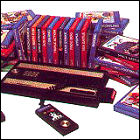 The video game division of #1 toy maker Mattel closes its doors immediately after the parent company announces that it lost well over $300,000,000 over the course of 1983, with all of thoses losses occurring within its video game business. The remaining stock of Mattel’s Intellivision video game system and its software are liquidated, and the entire electronics division is laid off. The popularity of its Masters Of The Universe toys and perennial favorites such as Hot Wheels and Barbie are barely enough to keep the entire company out of bankruptcy court.
The video game division of #1 toy maker Mattel closes its doors immediately after the parent company announces that it lost well over $300,000,000 over the course of 1983, with all of thoses losses occurring within its video game business. The remaining stock of Mattel’s Intellivision video game system and its software are liquidated, and the entire electronics division is laid off. The popularity of its Masters Of The Universe toys and perennial favorites such as Hot Wheels and Barbie are barely enough to keep the entire company out of bankruptcy court.
Corporate networking
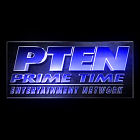 Hobbled by the recent half-billion-dollar losses of its Atari division, Warner Communications finds itself vulnerable to a potential hostile takeover by Australian publisher Rupert Murdoch, who isn’t shy about his plan to acquire a controlling interest in Warner’s very slowly recovering stock. To stave off Murdoch’s takeover attempt, a 19% stake in Warner is traded for 43% of Chris-Craft Industries’ broadcasting division, BHC Communications. This transaction later has unforseen consequences, including BHC’s near-successful 1989 attempt to block the Time Warner merger, and the creation of the short-lived PTEN television network, a failed 1990s venture whose main claim to fame will be the science fiction series Babylon 5.
Hobbled by the recent half-billion-dollar losses of its Atari division, Warner Communications finds itself vulnerable to a potential hostile takeover by Australian publisher Rupert Murdoch, who isn’t shy about his plan to acquire a controlling interest in Warner’s very slowly recovering stock. To stave off Murdoch’s takeover attempt, a 19% stake in Warner is traded for 43% of Chris-Craft Industries’ broadcasting division, BHC Communications. This transaction later has unforseen consequences, including BHC’s near-successful 1989 attempt to block the Time Warner merger, and the creation of the short-lived PTEN television network, a failed 1990s venture whose main claim to fame will be the science fiction series Babylon 5.
Space Shuttle: A Journey Into Orbit
 Activision releases the Space Shuttle cartridge for the Atari 2600 home video game system, an attempt to do a realistic flight simulator on limited hardware. Many of the console’s option switches – normally used to toggle difficulty levels, color or black & white graphics, and so on – are used for in-game functions instead.
Activision releases the Space Shuttle cartridge for the Atari 2600 home video game system, an attempt to do a realistic flight simulator on limited hardware. Many of the console’s option switches – normally used to toggle difficulty levels, color or black & white graphics, and so on – are used for in-game functions instead.
Pole Position II
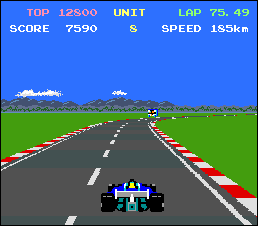 Atari’s arcade game Pole Position II, originated by Japanese manufacturer Namco, is released in the United States. A sequel to the hit racing game Pole Position, this game adds new tracks and improved graphics.
Atari’s arcade game Pole Position II, originated by Japanese manufacturer Namco, is released in the United States. A sequel to the hit racing game Pole Position, this game adds new tracks and improved graphics.
Activision layoffs begin
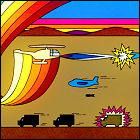 The first video game company to produce only software without a hardware platform of its own, Activision is heavily dependent on the Atari 2600 – and Atari’s falling fortunes bring Activision down with it. After third quarter losses of $4,000,000, a quarter of Activision’s workforce is laid off; Activision CEO Jim Levy cautiously predicts better results in 1984.
The first video game company to produce only software without a hardware platform of its own, Activision is heavily dependent on the Atari 2600 – and Atari’s falling fortunes bring Activision down with it. After third quarter losses of $4,000,000, a quarter of Activision’s workforce is laid off; Activision CEO Jim Levy cautiously predicts better results in 1984.
Texas Instruments out of computer business
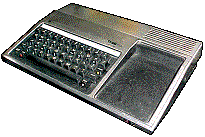 After a six-month loss totaling over $200,000,000, Texas Instruments puts its computer division out of its misery immediately, ending all manufacturing and support for the TI 99/4a home computer. Prices on the remaining stock of TI computers drop well below the $100 mark, and the company lays off thousands of employees; third-party software and peripheral vendors such as Milton Bradley take a hit by the end of the year as a result. Company executives describe TI’s losses in 1983 so far as the worst that the company has ever suffered.
After a six-month loss totaling over $200,000,000, Texas Instruments puts its computer division out of its misery immediately, ending all manufacturing and support for the TI 99/4a home computer. Prices on the remaining stock of TI computers drop well below the $100 mark, and the company lays off thousands of employees; third-party software and peripheral vendors such as Milton Bradley take a hit by the end of the year as a result. Company executives describe TI’s losses in 1983 so far as the worst that the company has ever suffered.
Pressure Cooker
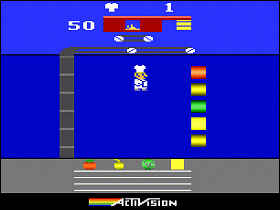 Activision releases the Pressure Cooker cartridge for the Atari 2600 home video game system. A fast-paced video game version of the fast food industry, Pressure Cooker turns players into short-order cooks with very little time to accurately build burgers to order.
Activision releases the Pressure Cooker cartridge for the Atari 2600 home video game system. A fast-paced video game version of the fast food industry, Pressure Cooker turns players into short-order cooks with very little time to accurately build burgers to order.
Coleco ships Adam home computer
 Having claimed from the start that a computer add-on for its Colecovision console would be forthcoming, Coleco delivers on the promise with the first shipments of Adam home computer systems. Compatible with Colecovision games, Adam proves to be an immediate setback to the company due to serious technical problems and product failures, leading to a startling fourth-quarter shortfall at the end of 1983.
Having claimed from the start that a computer add-on for its Colecovision console would be forthcoming, Coleco delivers on the promise with the first shipments of Adam home computer systems. Compatible with Colecovision games, Adam proves to be an immediate setback to the company due to serious technical problems and product failures, leading to a startling fourth-quarter shortfall at the end of 1983.
Track & Field
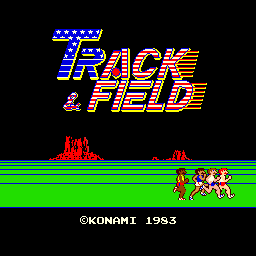 Konami introduces the arcade game Track & Field in the United States, a multi-event game built around a summer Olympic theme. Due to the nature of the game’s control scheme, the Track & Field coin-ops take a huge amount of abuse as players pound the action buttons to determine the “intensity” of their on-screen athletes’ movement.
Konami introduces the arcade game Track & Field in the United States, a multi-event game built around a summer Olympic theme. Due to the nature of the game’s control scheme, the Track & Field coin-ops take a huge amount of abuse as players pound the action buttons to determine the “intensity” of their on-screen athletes’ movement.
Gateway To Apshai
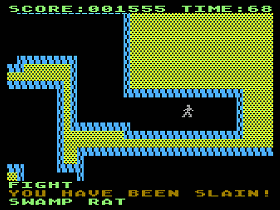 The third and final game in Epyx’s “Apshai trilogy” is released for various home computer platforms. Gateway To Apshai continues the trend of pushing traditionally turn-based computer RPGs toward real-time action games, a trend that will culminate in the smash success of the unrelated NES game The Legend Of Zelda years later.
The third and final game in Epyx’s “Apshai trilogy” is released for various home computer platforms. Gateway To Apshai continues the trend of pushing traditionally turn-based computer RPGs toward real-time action games, a trend that will culminate in the smash success of the unrelated NES game The Legend Of Zelda years later.
Ex-Atari CEO charged with insider trading
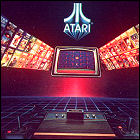 Months after his resignation as CEO of Atari, Ray Kassar is hit with charges of insider trading by the Securities & Exchange Commission. At issue, according to the SEC, is the sudden sale of 5,000 shares in Atari’s parent company, Warner Communications, 23 minutes before a statement was issued indicating that Atari would not meet shareholders’ expectations in the fourth quarters of 1982. Other Atari executives are also charged with similar last-minute sell-offs.
Months after his resignation as CEO of Atari, Ray Kassar is hit with charges of insider trading by the Securities & Exchange Commission. At issue, according to the SEC, is the sudden sale of 5,000 shares in Atari’s parent company, Warner Communications, 23 minutes before a statement was issued indicating that Atari would not meet shareholders’ expectations in the fourth quarters of 1982. Other Atari executives are also charged with similar last-minute sell-offs.
Atari in the dumps
 In what is perhaps the most tangible event of the entire video game industry crash in 1983, Atari dumps 14 truckloads of unsold game cartridges and other parts in the Alamagordo, New Mexico city dump, with security guards standing by to keep curious onlookers from grabbing any “souvenirs” before concrete is poured over them. The unsold merchandise is stock left over from the closure of Atari’s cartridge assembly plant in El Paso, Texas. Second-quarter earnings report reveal that Atari has lost over $300,000,000 since the beginning of 1983.
In what is perhaps the most tangible event of the entire video game industry crash in 1983, Atari dumps 14 truckloads of unsold game cartridges and other parts in the Alamagordo, New Mexico city dump, with security guards standing by to keep curious onlookers from grabbing any “souvenirs” before concrete is poured over them. The unsold merchandise is stock left over from the closure of Atari’s cartridge assembly plant in El Paso, Texas. Second-quarter earnings report reveal that Atari has lost over $300,000,000 since the beginning of 1983.
The Imagic just isn’t there anymore
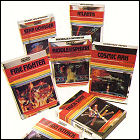 Software company Imagic, which started out marketing games for the Atari VCS before branching out into the Intellivision, Colecovision, home computer and even Odyssey2 markets, nixes plans to sell public stock in the company. Shortly afterward, 40 of Imagic’s 170 employees are laid off, with every indiciation that more employees will follow as the company tries to stay afloat. Potential investors are told that Imagic’s initial public offering has been delayed until early 1984, but stock in the company is never sold.
Software company Imagic, which started out marketing games for the Atari VCS before branching out into the Intellivision, Colecovision, home computer and even Odyssey2 markets, nixes plans to sell public stock in the company. Shortly afterward, 40 of Imagic’s 170 employees are laid off, with every indiciation that more employees will follow as the company tries to stay afloat. Potential investors are told that Imagic’s initial public offering has been delayed until early 1984, but stock in the company is never sold.
The crash
 After dismal second-quarter earnings reports lead to weeks of massive sell-offs of Warner Communications and Texas Instruments stock (among many other companies tied into the field of computer and video games), investment firm Prudential-Bache Securities – usually a staunch supporter of tech stocks – kicks the industry crash into high gear with a simple warning: do not buy. Stock prices for video game and computer companies tumble precipitously for the remainder of 1983, driving some of the industry’s longest-lived players out of the business (or out of business altogether). Even relatively stable stocks such as Apple and Coleco take a major hit; computer manufacturers and arcade-only game makers who have made it through the first half of 1983 unscathed find their stock valued at half of what it was worth just weeks before. In many respects this marks the end of the home-grown American video game industry: the next wave of successful products will arrive from Japan, and American software houses will rely on those machines to run their products.
After dismal second-quarter earnings reports lead to weeks of massive sell-offs of Warner Communications and Texas Instruments stock (among many other companies tied into the field of computer and video games), investment firm Prudential-Bache Securities – usually a staunch supporter of tech stocks – kicks the industry crash into high gear with a simple warning: do not buy. Stock prices for video game and computer companies tumble precipitously for the remainder of 1983, driving some of the industry’s longest-lived players out of the business (or out of business altogether). Even relatively stable stocks such as Apple and Coleco take a major hit; computer manufacturers and arcade-only game makers who have made it through the first half of 1983 unscathed find their stock valued at half of what it was worth just weeks before. In many respects this marks the end of the home-grown American video game industry: the next wave of successful products will arrive from Japan, and American software houses will rely on those machines to run their products.
Nintendo Famicom
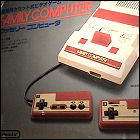 In Japan, Nintendo launches the Famicom (Family Computer) home video game system, with a few games available at the product’s launch, all of which are ports of popular Nintendo arcade games. Within months, major technical problems are reported and faulty consoles are returned, and Nintendo discovers that a design flaw is responsible. All Famicom units are recalled and refurbished at the company’s expense. In two years, the console will be launched in North America as the Nintendo Entertainment System, almost single-handedly reviving the video game industry around the world.
In Japan, Nintendo launches the Famicom (Family Computer) home video game system, with a few games available at the product’s launch, all of which are ports of popular Nintendo arcade games. Within months, major technical problems are reported and faulty consoles are returned, and Nintendo discovers that a design flaw is responsible. All Famicom units are recalled and refurbished at the company’s expense. In two years, the console will be launched in North America as the Nintendo Entertainment System, almost single-handedly reviving the video game industry around the world.
Atari CEO Ray Kassar resigns
 With the video game industry crash taking its toll, and Atari’s financial status in free-fall, CEO Ray Kassar resigns from the company shortly after a disastrous earnings report showing two straight quarters of multi-million dollar losses – the first Warner Communications suffered since the year before it bought Atari and installed Kassar as CEO. Kassar has also drawn fire for accusations that he sold thousands of shares of his Warner stock minutes prior to the fateful December 1982 announcement that heralded the beginning of the industry’s downturn. Kassar is replaced by former Philip Morris marketing VP James Morgan, who has no prior experience in the consumer electronics field; his previous experience has been in tobacco marketing.
With the video game industry crash taking its toll, and Atari’s financial status in free-fall, CEO Ray Kassar resigns from the company shortly after a disastrous earnings report showing two straight quarters of multi-million dollar losses – the first Warner Communications suffered since the year before it bought Atari and installed Kassar as CEO. Kassar has also drawn fire for accusations that he sold thousands of shares of his Warner stock minutes prior to the fateful December 1982 announcement that heralded the beginning of the industry’s downturn. Kassar is replaced by former Philip Morris marketing VP James Morgan, who has no prior experience in the consumer electronics field; his previous experience has been in tobacco marketing.
Robot Tank
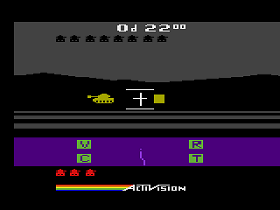 Activision releases the Robot Tank cartridge for the Atari 2600 home video game system, Activision’s answer to Atari’s home verison of Battlezone. As usual, Activision raises the ante with such features as a night vision mode and multiple targets.
Activision releases the Robot Tank cartridge for the Atari 2600 home video game system, Activision’s answer to Atari’s home verison of Battlezone. As usual, Activision raises the ante with such features as a night vision mode and multiple targets.
US Games closes its doors
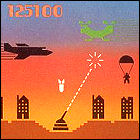 A latecomer to the glut of companies trying to provide software for the Atari 2600 video game system, US Games is closed down by its parent companies, Quaker Oats and Fisher-Price. Barely a year old, and with only 14 titles released, US Games is dubbed “an experiment” – but apparently not an experiment capable of surviving in the rapidly contracting video game market.
A latecomer to the glut of companies trying to provide software for the Atari 2600 video game system, US Games is closed down by its parent companies, Quaker Oats and Fisher-Price. Barely a year old, and with only 14 titles released, US Games is dubbed “an experiment” – but apparently not an experiment capable of surviving in the rapidly contracting video game market.
Dragon’s Lair
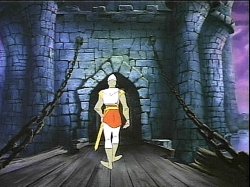 The ongoing race to improve arcade game graphics takes a sudden turn with the introduction of the first laserdisc-driven game to hit arcades, Dragon’s Lair. Featuring animation by former Disney protege Don Bluth, and a branching structure that depends heavily on players performing the right actions at just the right times, Dragon’s Lair is rigid in game play, but breathtaking in beauty; most arcade operators set the price for a single game at 50 cents just to offset the cost of the machine – and players gladly wait in line just to watch others guide Dirk the Daring through the castle.
The ongoing race to improve arcade game graphics takes a sudden turn with the introduction of the first laserdisc-driven game to hit arcades, Dragon’s Lair. Featuring animation by former Disney protege Don Bluth, and a branching structure that depends heavily on players performing the right actions at just the right times, Dragon’s Lair is rigid in game play, but breathtaking in beauty; most arcade operators set the price for a single game at 50 cents just to offset the cost of the machine – and players gladly wait in line just to watch others guide Dirk the Daring through the castle.
Lode Runner
 Broderbund Software introduces the earliest versions of Doug Smith’s computer game Lode Runner to hit the market. Inspired by the obscure arcade game Space Panic, Lode Runner gives players a weapon that digs rather than directly disabling enemies. A game franchise spanning multiple platforms and decades is spawned.
Broderbund Software introduces the earliest versions of Doug Smith’s computer game Lode Runner to hit the market. Inspired by the obscure arcade game Space Panic, Lode Runner gives players a weapon that digs rather than directly disabling enemies. A game franchise spanning multiple platforms and decades is spawned.
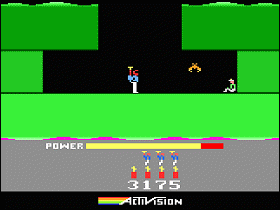 Activision releases the
Activision releases the 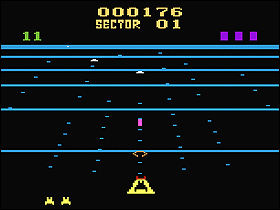 Activision releases the
Activision releases the